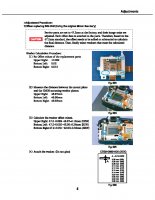I don't think anything will be announced on 5th, except lenses. Hard to believe there are no credible leaks only days before the announcement.
Upvote
0
My hypothesis, FWIW, and based on the limited information we've seen here, is that there is some type of automatic flange extension that pushes out the required 1/4 to 1/2 inch when an EF lens is mounted, but locks in the recessed position when it is an "R" lens.
Seems complicated, but maybe.
An electronically curved sensor would be sexy, especially if it can change its curve to suit the lensIs allllll that trouble worth a measly 1/4-1/2"?
I need something sexier than that to sign up for all his trouble. Faster than ring USM on SLR focusing. A modern 50 prime to go on that new mount. Something.
- A
Right! I certainly don't have large hands but I prefer the size of my 7D to my 6D.Considering that the 5D series is a little too thin for my hands, I certainly wouldn't be interested in a thinner body than that.
I'm sceptical of this EF-depth body with R-mount lenses that sit deep in the body. This suggests the mount is offset part way up the lens barrel.
In addition, those R-mount lenses intended for this first-generation mirrorless will have an outer barrel thin enough to go through the EF mount which means that they will be narrower lens elements than native lenses.
As and when Canon go full-bore mirrorless in 5-10 years time and start to make bodies that are thinner and lighter, I presume they will have a full-on 54mm R mount and Canon will have to design a whole new set of R-mount lenses - and the lenses they buy now will not be compatible with the future mirrorless body.
Or am I missing something?
Not so needlessly, full compatibility with all those EF lenses.Keeping the native registration distance of EF lenses sounds like a terrible idea to me. I sincerely hope Canon doesn't do that. It would mean needlessly fatter bodies, etc.
Many wide angle lenses have rear elements that are already much smaller in diameter than the 54 mm EF mount. And, non-retrofocus designs of the past almost always had small rear elements. Nice article here: https://www.bhphotovideo.com/explor...review-non-retrofocus-ultra-wide-angle-lenses
EOS not designed for FF? It was designed for 35mm film, the original FF.In an interview with the Canon team, one of the designers stated that the EOS was not designed for FF.
I have several F to EF adaptors, I keep them on each of my Nikon lenses. They have been available for many years. There are a very few that adapt Nikon lenses with no aperture rings, but they exist.Forgive me, I always thought EF and F were sufficiently close on flange distance that adapting would be impossible. (Aren't they only a couple mm apart?)
- A
Longer than about 40mm, the EF mount works fine--no need to recess the lens.That is wide-angle sorted, but what about standard to telephoto, or zooms?
That is wide-angle sorted, but what about standard to telephoto, or zooms?
Yes, but adapting an EF lens to F would mean the lens needs a reduced flange distance than the f-mount can provide (if I understand correctly). I would suspect that any adapter which allowed an EF lens to be mounted to F mount would need optics?I have several F to EF adaptors, I keep them on each of my Nikon lenses. They have been available for many years. There are a very few that adapt Nikon lenses with no aperture rings, but they exist.
https://photographylife.com/reviews/novoflex-nikon-canon-lens-adapter
A moveable sensor doesn’t sound so bad to me. I’d think that the sensor would only move in a macro way with lens changes, I change lenses on a given body less than ten times a day even with busy shooting. If another lens is needed it usually goes on a separate body. So a moveable sensor perhaps on a rail, could be called upon with lens type changes. EOS R for railed sensor.
Canon already has patents for conformational sensor changes, so this is not a bridge too far.
Such a system would probably require more than than 1/4 to 1/2 inch extension; more like 26 mm (more than an inch) since EF is at 44 mm and thin mirrorless much shorter (18 mm for EF-M). If they want to do something like this it would be better done on the lens rather than in the camera. I hope Canon makes a thin mirrorless, but they could make some new WA lenses for it that could extend into the live-view mirror-box of EF DSLRs so everyone can use them.

It is not only mirror that can go into that space. For example, EF mount videocameras keep their ND filter wheels there.I'm assuming that because that's the most sensible design once the mirror is removed. A mirror box space with no mirror is very inelegant.
1) MLU + Liveview on an SLR does not allow you to hold the camera up to your eye unless you design a hybrid VF or use some comical eye loupe on the back LCD.
2) An SLR design -- even with MLU + liveview -- cannot adapt other people's lenses.
